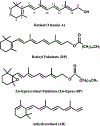Photomutagenicity of anhydroretinol and 5,6-epoxyretinyl palmitate in mouse lymphoma cells
- PMID: 17112230
- PMCID: PMC6371395
- DOI: 10.1021/tx0600907
Photomutagenicity of anhydroretinol and 5,6-epoxyretinyl palmitate in mouse lymphoma cells
Abstract
Retinyl palmitate (RP) is frequently used as an ingredient in cosmetics and other retail products. We previously reported that, under UVA light irradiation, RP is facilely decomposed into multiple products, including anhydroretinol (AR) and 5,6-epoxyretinyl palmitate (5,6-epoxy-RP). We also determined that combined treatment of mouse lymphoma cells with RP and UVA irradiation produced a photomutagenic effect. In this study, we evaluated the photomutagenicity of AR and 5,6-epoxy-RP, in L5178Y/Tk+/- mouse lymphoma cells. Treatment of cells with AR or 5,6-epoxy-RP alone at 10 and 25 microg/mL for 4 h did not show a positive mutagenic response. However, because these doses did not induce the required amount of cytotoxicity for mouse lymphoma assay, we are unable to determine whether or not these two compounds are mutagenic. Treatment of cells with 1-25 microg/mL AR or 5,6-epoxy-RP under UVA light (315-400 nm) for 30 min (1.38 mW/cm2) produced a synergistic photomutagenic effect. At 10 microg/mL (37.3 microM) AR with UVA exposure, the mutant frequency (MF) was about 3-fold higher than that for UVA exposure alone, whereas the MF for 25microg/mL (46.3microM) of 5,6-epoxy-RP + UVA was approximately 2-fold higher than that for UVA exposure alone. Compared with previous results for RP + UVA treatment, the potency of the induced phototoxicity and photomutagenicity was AR > RP > 5,6-epoxy-RP. To elucidate the underlying photomutagenic mechanism, we examined the loss of heterozygosity (LOH) at four microsatellite loci spanning the entire chromosome 11 for mutants induced by AR or 5,6-epoxy-RP. Most mutants lost the Tk+ allele, and more than 70% of the chromosome damage extended to 38 cM in chromosome length. AR + UVA induced about twice as many mutants that lost all four microsatellite markers from the chromosome 11 carrying the Tk+ allele as RP + UVA or 5,6-epoxy-RP + UVA. These results suggest that two of RP's photodecomposition products are photomutagenic in mouse lymphoma cells, causing events that affect a large segment of the chromosome.
Figures




Similar articles
-
Cytotoxicity and mutagenicity of retinol with ultraviolet A irradiation in mouse lymphoma cells.Toxicol In Vitro. 2010 Mar;24(2):439-44. doi: 10.1016/j.tiv.2009.10.004. Epub 2009 Oct 14. Toxicol In Vitro. 2010. PMID: 19835946 Free PMC article.
-
Photomutagenicity of retinyl palmitate by ultraviolet a irradiation in mouse lymphoma cells.Toxicol Sci. 2005 Nov;88(1):142-9. doi: 10.1093/toxsci/kfi291. Epub 2005 Aug 17. Toxicol Sci. 2005. PMID: 16107546 Free PMC article.
-
Photo-induced DNA damage and photocytotoxicity of retinyl palmitate and its photodecomposition products.Toxicol Ind Health. 2005 Sep;21(7-8):167-75. doi: 10.1191/0748233705th225oa. Toxicol Ind Health. 2005. PMID: 16149731
-
Photodecomposition of retinyl palmitate in ethanol by UVA light-formation of photodecomposition products, reactive oxygen species, and lipid peroxides.Chem Res Toxicol. 2005 Feb;18(2):129-38. doi: 10.1021/tx049807l. Chem Res Toxicol. 2005. PMID: 15720116
-
Photodecomposition and phototoxicity of natural retinoids.Int J Environ Res Public Health. 2005 Apr;2(1):147-55. doi: 10.3390/ijerph2005010147. Int J Environ Res Public Health. 2005. PMID: 16705812 Free PMC article. Review.
Cited by
-
Silver nanoparticle-induced mutations and oxidative stress in mouse lymphoma cells.Environ Mol Mutagen. 2012 Jul;53(6):409-19. doi: 10.1002/em.21698. Epub 2012 May 10. Environ Mol Mutagen. 2012. PMID: 22576574 Free PMC article.
-
Nitroxide TEMPO: a genotoxic and oxidative stress inducer in cultured cells.Toxicol In Vitro. 2013 Aug;27(5):1496-502. doi: 10.1016/j.tiv.2013.02.019. Epub 2013 Mar 18. Toxicol In Vitro. 2013. PMID: 23517621 Free PMC article.
-
Cytotoxicity and mutagenicity of retinol with ultraviolet A irradiation in mouse lymphoma cells.Toxicol In Vitro. 2010 Mar;24(2):439-44. doi: 10.1016/j.tiv.2009.10.004. Epub 2009 Oct 14. Toxicol In Vitro. 2010. PMID: 19835946 Free PMC article.
-
In vitro investigation of the mutagenic potential of Aloe vera extracts.Toxicol Res (Camb). 2014 Nov;3(6):487-496. doi: 10.1039/c4tx00053f. Epub 2014 Aug 11. Toxicol Res (Camb). 2014. PMID: 33953902 Free PMC article.
-
Quantitative analysis of the relative mutagenicity of five chemical constituents of tobacco smoke in the mouse lymphoma assay.Mutagenesis. 2016 May;31(3):287-96. doi: 10.1093/mutage/gev039. Epub 2015 May 22. Mutagenesis. 2016. PMID: 26001754 Free PMC article.
References
-
- Mukhtar H (1995) Skin Cancer: Mechanisms and Human Relevance CRC Press: Boca Raton, FL.
-
- Ahmad N, and Mukhtar H (2004) Toxicology of the skin: new and emerging concepts. Toxicol. Appl. Pharm 195, 265–266.
-
- International Agency for Research on Cancer (IARC). (1998) Handbooks of Cancer Prevention, Vitamin A Vol. 3, Lyon, France.
-
- Idson B (1990) Vitamins in cosmetics, an update I. Overview and Vitamin A. Drug Cosmet. Ind 146, 26–91.
-
- Tee ES (1992) Carotenoids and retinoids in human nutrition. Crit. Rev. Food Sci. Nutr 31, 103–163. - PubMed
Publication types
MeSH terms
Substances
Grants and funding
LinkOut - more resources
Full Text Sources
Medical
Research Materials

